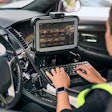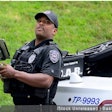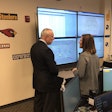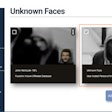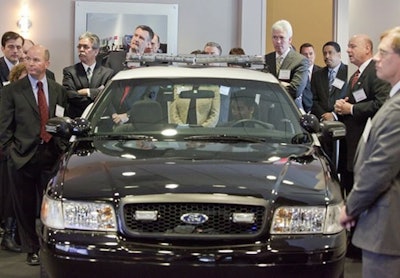 Raytheon executives and guests watch a video feed provided by a cruiser-mounted camera. Photo: Raytheon
Raytheon executives and guests watch a video feed provided by a cruiser-mounted camera. Photo: Raytheon
Consider what you would do in each of the following scenarios, and ask yourself what technologies you would want on hand to deal with these crises more effectively:
- An active shooter terrorizes a military facility.
- A terrorist with a bomb-like device strapped to his body enters Los Angeles International Airport's Terminal 4.
- A suspect with a deadly gas device is about to walk into a state building.
These questions were posed to public safety leaders during the first counterterrorism workshop at the University of California, Los Angeles' Public Safety Network Systems Laboratory in December. The attendees included representatives from the FBI, LAPD, Los Angeles World Airports and San Bernardino County Sheriff's Department.
They drew up a wish list (see below) of future technologies. Of course, any privacy concerns would need to be addressed while these technologies are being developed or adapted for police work, not after the fact.
- Next Generation 9-1-1 that can receive incident-related pictures from mobile phones with geo-location data attached. Also, social media posts and tweets sent from the public that contain longitude and latitude coordinates.
- Communications systems that are interoperable, resilient, redundant, and secure. First responders should be able to communicate with each other through an open architecture system that integrates any communications device.
- Facial recognition technologies and Future Attribute Screening Technology (FAST) that can help identify people who may be dangerous.
- Automated license plate readers at key facilities or city entry and exit points for alerting and investigative purposes.
- Blue force tracking that shows where team members are in three dimensions. This could be used within buildings and include building schematics.
Raytheon's new Public Safety Regional Technology Center in Downey, Calif., near Los Angeles provides one avenue for developing these technologies. This 27,000-square-foot facility opened in February and has been built to design, test, and certify public safety technologies. The center focuses on addressing first responders' needs by working on technologies that can improve public safety communications, reduce a department's costs, and save lives.
Several battlefield-tested devices that Raytheon has adapted for public safety use are also on display and can be tried out in hands-on demonstrations. There's the Boomerang shooter detection system that helps immediately locate the source of firearms being discharged; the Controlled Impact Rescue Tool that's capable of cutting through a reinforced concrete wall up to four times faster than traditional methods of drilling or sawing; and TransTalk, a mobile phone app that directly translates languages, including a soon-to-be-released English-to-Spanish version.
Any police department is welcome to use the facility for testing purposes, as well as to propose an idea or issue that researchers, industry and the public safety community can solve on a collaborative basis. I wish we had a place like this when I was with the LAPD.
Learn more about the Public Safety Regional Technology Center, by clicking here.
Related:










